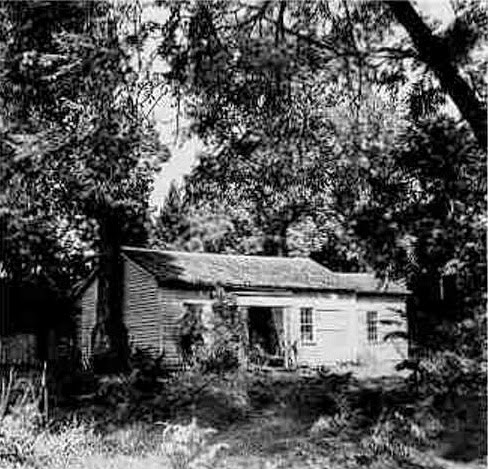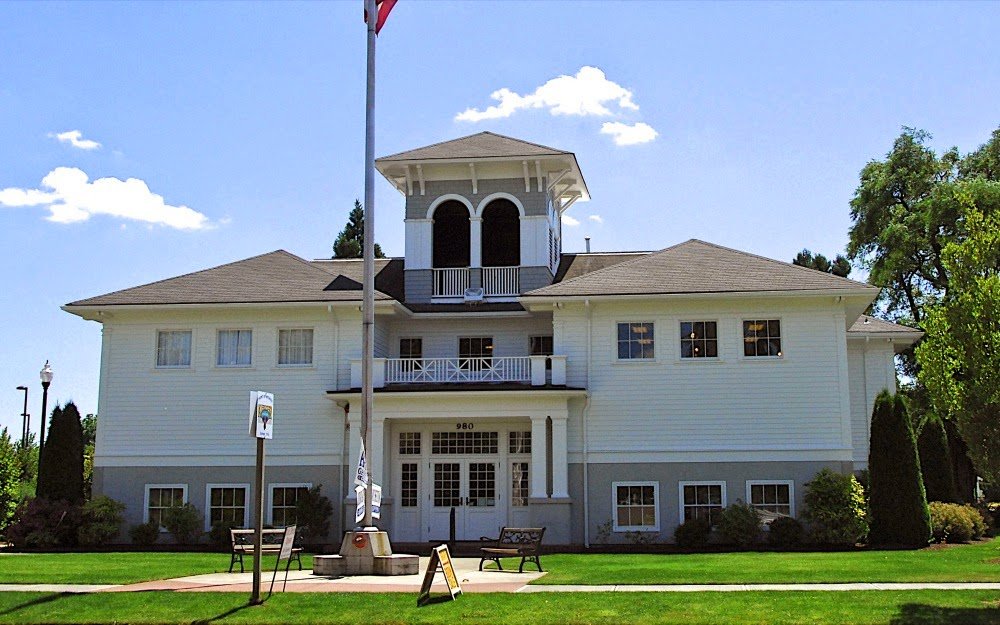 |
| 1940s photograph of Fernhazel, the Zieber family home |
Late in October of 2012, we met Evelyn Melson Franz, a volunteer at the Keizer Heritage Museum. Her father’s farm was near the intersection of Cherry Avenue and River Road. She remembers the 1930s Russell Ward and Keizer Feed stores, first in that rural area. These family farms were connected to Salem by Front Street and to Portland by Highway 99 (an extension of Capitol Street). Senior citizens of today’s urban Keizer, like Evelyn, remember the dirt roads on which they walked (or rode bicycles) to Parrish Junior High ~ in the city.
Less than a mile north of the Melson property was the 1916 Keizer School at the intersection of Chemawa and River Road (now a shopping center). Turning west, toward the Willamette River, Chemawa Road ended near the present Keizer Rapids Park. This park is near the land claims of pioneers John Shunk Zieber and Thomas Dove Keizur. The park is one of our favorite sites for casual strolling ~ or strenuous hiking if we venture into the more remote trails ~ and we appreciate being in a landscape still very much as it was when these families arrived.
Although River’s Edge Park is probably the site of an early fur trader’s outpost (1811-13) and the house of William Wallace of Astoria, no trace of this history remains. Thomas Dove Keizur was the original, permanent settler in 1843. Somewhere in the translation of donation land claim records, his name was misspelled. That settlement suffered in the flood of 1861, and the inhabitants rebuilt their homes on higher ground.
The Zieber house, known as Fernhazel was located in the same area. He bought rights to the property in 1854 and completed the claim. Part of the house was originally a log cabin before Zieber put siding on the house and built additions. John Zieber was the father of Eugenia (1833-1863), wife of Asahel Bush. She died at the age of 30, after the birth of her fourth child. John Zieber was the grandfather of A.N. Bush who, as a young boy, used to stay here in an attic room. In 1946, Stuart Bush, A. N.’s grandson, had the house demolished.
Floods in 1943, 1945, 1946 and 1948 hampered the growth of the community, and it was not until dams were built in the 1950s to regulate the flow of the Willamette that Keizer began to flourish. However, another flood in 1993 caused some families to evacuate their homes along the river.
The most noted resident of Keiser was Charles McNary, a prominent United States Senator from 1917 until his death in 1944. Although born on his family’s farm, he lived in Salem during the early years of his career, moving back to family property in the 1930s. Fir Cone, his spacious farm home where he cultivated nut and fruit trees, was in the area now known as McNary Estates. A horticulturist, Senator McNary introduced the Italian prune and the Barcelona filbert to growers in Oregon. The house was demolished sometime after his death in 1944.
Another well-known personality was Lucille Cummings Bagley (1914-2012) who told the story of her career in A Musical Journey. She is best known for her operatic performances with the New York City Center Opera and Radio City Music Hall.
Many times the City of Salem tried to annex the growing community adjacent to its city limits. Beginning in 1964, a number of Keizer residents tried to convince the residents that it would be cheaper and better to form their own city. It was not until November 2, 1982, when, with the support of the nearby unincorporated community of Clear Lake, residents voted to make Keizer a city.
 |
| Keizer Heritage Center |
Today the remaining farmland of Keizer is hidden to the east and north, beyond the core of business and residential developments. Driving north on Front Street, or the more recent Broadway, these Salem streets meet at a traffic light and passing through, you will be in Keizer. It is hard to know you have traveled from one city to another, except that you are now on North River Road, the commercial spine of the city. This street stretches the length of Keizer, becomes Highway 221 and, as French Prairie Road, leads to the earliest settlements of Marion County. A turn to the right at Chemawa Road takes you to the handsome new City Hall, the Keizer Heritage Center and so on to the northwest city limits and I-5 at Keizer Station shopping complex.
According to a recent Statesman Journal statement, “Keizer has established its own identity: minimal but effective city services, low taxes, a commitment to youth and family, and a passion for volunteerism. In its own estimation in a recent publication: Keizer is a relatively young city, continuing to mature and develop, never forgetting its commitment to preserve its heritage and small-town values. Keizer’s motto is Pride, Spirit, and Volunteerism”.
The city’s size is 7.3 square miles and it has a population of 36,478. Among the recent improvements, in addition to the City Hall, is the Keizer Station retail complex north of town on I-5 and the Keizer Rapids Park. One subject of development that has been rejected in Keizer is a tax-supported public library facility. Cost seems to be the main reason the city is reluctant to join the Chemeketa Cooperative Regional Library Service.
The section of the city nearest to Salem now has residential developments typical of the 1950s-1970s. Along the Willamette River, there are many newer homes on larger properties and several neighborhood parks. Keizer, unlike Salem, developed their beautiful riverfront for residential enjoyment.
 |
| The Keizer Museum |
The Keizer Heritage Museum is inside the Keizer Heritage Community Center, which was formerly the Keizer School. The school, built in 1916, has been moved east on Chemawa Road from its original location on North River Road, has been completely restored and is the only public historic building in Keizer. (Open 2-4 p.m. on Tuesday and Thursday, Saturday 10am to 4pm.) We like to visit here to see how other tenants, including the Keizer Community Library and the Keizer Art Association and Gallery, use this handsome building. The gallery changes exhibits each month and welcomes visitors.
An interesting landmark that may be passed without notice is the brick monument in the 5000 block of River Road North, marking the 45th Parallel.
Each Tuesday, after a city was featured in that Sunday’s Statesman Journal, KMUZ broadcasted “Marion County 20”. To learn more about Keizer, listen to the podcast listed on the KMUZ archives.

One Comment